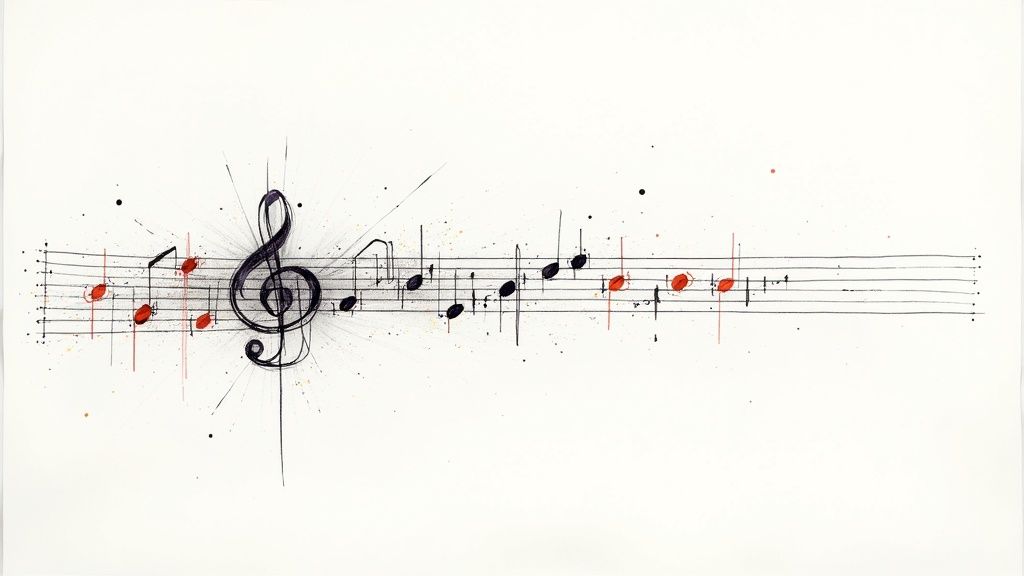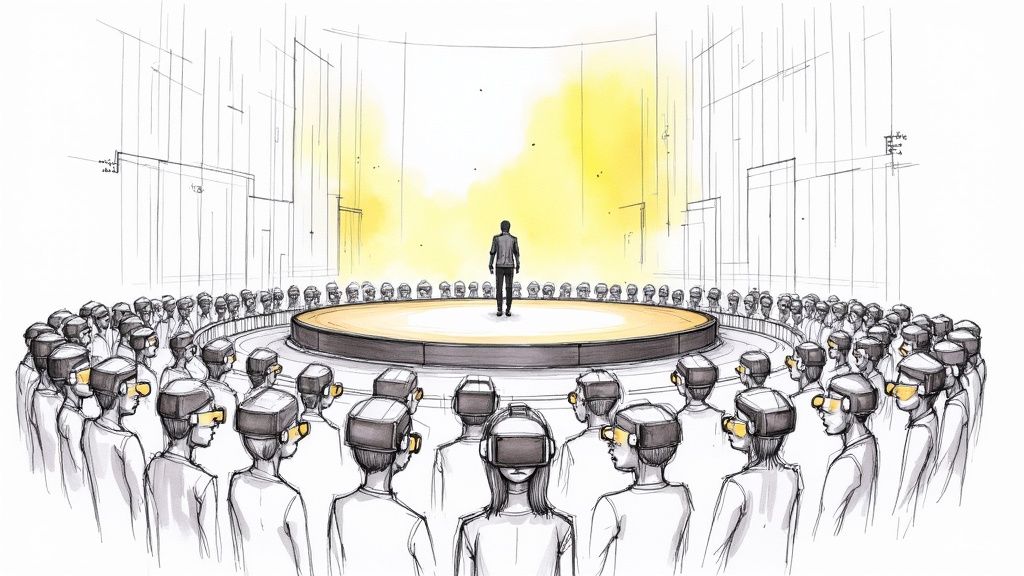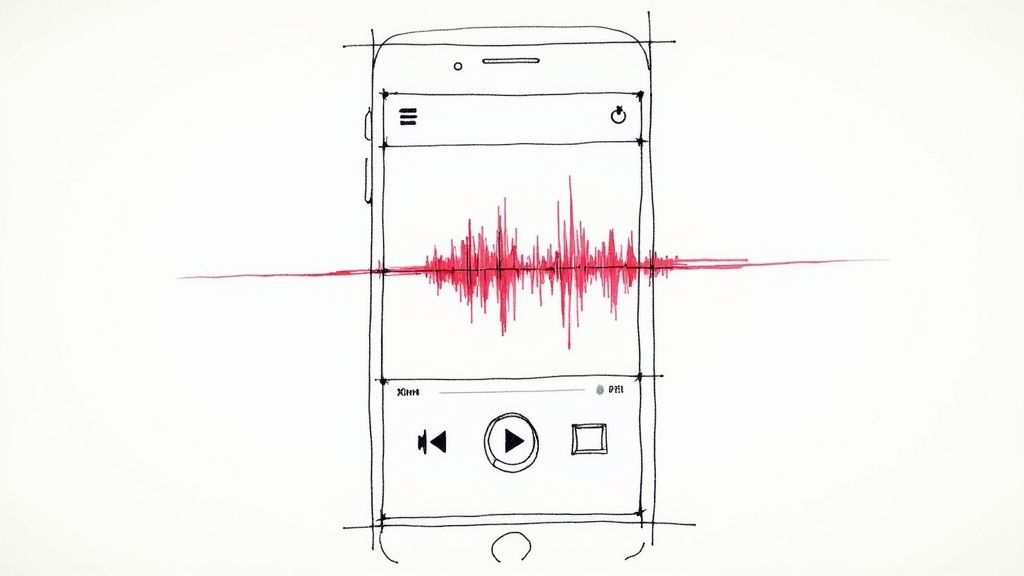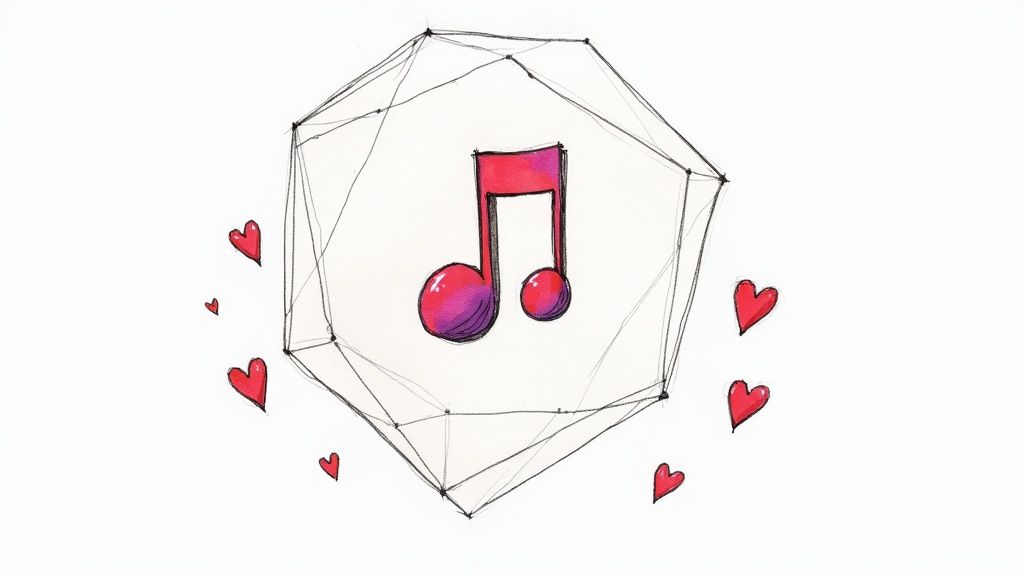9 Key Music Industry Trends to Watch in 2025
- Tamara Bosmans
- Jul 5
- 14 min read
The music landscape is transforming faster than ever, driven by technological leaps and shifting listener habits. For artists, labels, and curators, understanding these changes isn't just beneficial; it's essential for survival and success in a competitive market. Staying ahead requires more than just awareness; it demands a strategic approach to capitalize on emerging opportunities. This is precisely why we've analyzed the most significant shifts to bring you a definitive guide.
This article dives deep into the nine pivotal music industry trends shaping 2025. We'll move beyond surface-level observations to provide a comprehensive roadmap, pairing each trend with actionable strategies. You will learn how to adapt your workflow, marketing, and monetization to thrive.
Crucially, we'll demonstrate how to leverage the data-driven power of to not just navigate these trends, but to master them. Our focus is on turning industry shifts into career-defining advantages. From the rise of AI in creation and promotion to the evolution of playlisting culture, this guide will equip you with the practical knowledge needed to gain a strategic edge in the new era of music. We will explore how to apply these insights directly to your projects, ensuring you are prepared for what's next.
1. Trend 1: AI as a Creative and Promotional Partner
Artificial intelligence is rapidly moving from a futuristic concept to a practical tool that is fundamentally reshaping music creation and marketing. This pivotal music industry trend sees AI not as a replacement for human creativity, but as a powerful collaborator. It excels at handling complex, data-heavy tasks, freeing artists to focus on their unique vision and emotional expression.

From generating novel chord progressions with tools like OpenAI's Jukebox to artists like Grimes and Holly Herndon using it as a direct creative partner, AI's influence is undeniable. Specifically, AI's role in enriching the creative process extends to applications like AI-powered music integration for video, where it can seamlessly sync audio and visual elements. On the promotional side, AI algorithms power features like Spotify's AI DJ and optimize targeted advertising campaigns with unprecedented precision.
How to Leverage This Trend
To capitalize on this trend, integrate AI strategically into your workflow. Use it as an efficient assistant to overcome creative blocks or handle repetitive tasks, not as the sole creator.
Brainstorming & Inspiration: Use AI melody or lyric generators to spark initial ideas. Take the strongest AI-generated concepts and infuse them with your personal style and instrumentation.
Intelligent Promotion: Leverage AI-powered platforms to analyze your track's sonic characteristics. These tools can then identify the most relevant playlist curators and suggest similar artists for targeting, streamlining your outreach.
Legal Awareness: Always understand the copyright and licensing implications of the AI tools you use. Policies vary widely, so ensure you have the rights to use the generated output commercially.
2. Streaming Platform Dominance and Playlist Culture
The reign of streaming platforms like Spotify and Apple Music has cemented playlists as the modern-day radio, fundamentally altering how listeners discover music. This pivotal music industry trend places immense power in the hands of both algorithmic and human curators, making a spot on a key playlist a career-defining moment. The culture has shifted from album-centric consumption to a continuous flow of individual tracks, influencing song structure, release strategies, and promotional focus.

This environment has propelled artists like Billie Eilish from bedroom pop creator to global superstar and turned tracks like Lil Nas X's "Old Town Road" into viral phenomena, largely through strategic playlist placements. Influential playlists such as RapCaviar can generate millions of streams overnight, demonstrating that getting heard is now synonymous with getting playlisted. For a deeper dive, you can explore the top music streaming statistics on artist.tools to understand the scale of this shift. This trend isn't just about discovery; it's a complete reimagining of the music consumption ecosystem.
How to Leverage This Trend
To succeed in this playlist-driven landscape, artists must adapt their creation and marketing strategies to be "playlist-friendly" from the very beginning. This means thinking like a curator and understanding listener behavior on these platforms.
Optimize for Playlisting: Craft songs with strong, immediate hooks and concise intros, as listeners often decide to skip within the first 30 seconds. Ensure your track's metadata, including genre, mood, and instrumentation tags, is accurate and detailed to help algorithms place your music correctly.
Build Curator Relationships: Identify independent curators and editors in your niche. Engage with their content authentically before pitching your music. A personalized, well-researched pitch is far more effective than a mass email blast.
Maintain a Consistent Release Cadence: Regularly releasing singles keeps your profile active on streaming platforms and provides more opportunities to land on algorithmic playlists like Discover Weekly and Release Radar. This strategy builds momentum and keeps your audience engaged between larger projects.
3. Virtual Concerts and Metaverse Performances
The fusion of virtual reality, augmented reality, and metaverse platforms is forging entirely new venues for musical expression. This music industry trend allows artists to stage digital concerts that offer deeply immersive experiences, shattering the geographical and physical limitations of traditional live shows. These performances enable artists to reach a massive global audience simultaneously and design fantastical stage productions that would be impossible to replicate in the real world.

This concept gained massive traction with events like Travis Scott's groundbreaking Fortnite concert, which drew over 12 million live viewers, and subsequent performances by artists like Ariana Grande and Lil Nas X on platforms such as Fortnite and Roblox. These are not just pre-recorded videos; they are interactive social events where fans can engage with the artist's avatar and each other within a shared digital space. For more on the technology enabling console-quality digital experiences directly through a web browser, explore how Pixel Streaming Explained: The Future of Cloud Gaming is shaping the future of interactive content.
How to Leverage This Trend
To tap into the metaverse, focus on creating an experience that is native to the digital world, not just a copy of a physical concert.
Create Interactive Elements: Go beyond just streaming a performance. Allow attendees to influence the show, unlock exclusive in-game items, or participate in mini-games related to your music.
Invest in Visuals: The appeal of a metaverse concert is its spectacle. Partner with digital artists and developers to create a visually stunning world that reflects your artistic brand and captures the imagination of the audience.
Monetize with Digital Merchandise: Complement your virtual performance with exclusive digital merchandise, like avatar skins, emotes, and virtual apparel. This creates a new, high-margin revenue stream that extends beyond the event itself.
4. Short-Form Content and TikTok Music Discovery
Short-form video platforms, led by TikTok, have fundamentally rewired the music discovery landscape, becoming primary launchpads for viral hits. This significant music industry trend prioritizes the creation of songs with memorable 15 to 30-second hooks designed for immediate impact. This "TikTok-ification" of music has altered songwriting structures, promotional strategies, and the very trajectory of an artist's career, making virality a key to mainstream success.

The platform's power is evident in countless success stories, from Lil Nas X's "Old Town Road" leveraging meme culture to global stardom, to Doja Cat’s "Say So" exploding through a viral dance challenge. It’s not just for new artists; legacy acts like Fleetwood Mac have seen massive resurgences, with "Dreams" re-entering the charts decades after its release thanks to a single viral video. This dynamic shows that a powerful, shareable moment can propel any song, new or old, to the top of the charts and into the cultural zeitgeist.
How to Leverage This Trend
To harness the power of short-form video, artists must think like content creators and build a strategy around engaging, repeatable audio clips. The goal is to make your music the soundtrack to a global conversation.
Engineer for Virality: When songwriting, intentionally craft a highly memorable and catchy 15-second section. This could be a unique lyric, a powerful instrumental drop, or a distinctive vocal melody that is easy for others to use in their own content.
Engage with Trends: Don't just post your music; participate in the platform's culture. Use trending sounds, engage with popular challenges, and collaborate with influential creators who align with your brand to introduce your music to their established audiences.
Optimize for Discoverability: A viral moment drives traffic to your profiles. Ensure your content strategy extends beyond a single platform and that your music is easily searchable, which can be enhanced by understanding SEO for musicians on artist.tools. Consistency is key to converting temporary buzz into a long-term fanbase.
5. Direct-to-Fan Monetization and NFTs
The shift towards direct-to-fan (D2F) monetization represents one of the most empowering music industry trends, allowing artists to bypass traditional industry gatekeepers. This model leverages platforms like Patreon, Bandcamp, and the emerging world of NFTs to create direct revenue streams from a dedicated fanbase. It’s about building a community and offering exclusive value that goes far beyond simple streams or downloads.
This trend gives artists unprecedented control over their careers and a deeper connection with their audience. We’ve seen its power in action through high-profile examples like Kings of Leon's "NFT Yourself" album and Grimes' multi-million dollar NFT art sales. As artists seek more independence, understanding the proven strategies for podcast monetization can offer valuable parallels for building a subscribership around audio content. D2F is not just about big one-off sales; it’s about creating sustainable income through genuine fan relationships.
How to Leverage This Trend
Success in D2F hinges on community and authenticity. Don’t just sell products; build a world around your music that fans want to be a part of. The key is to offer real value that makes supporters feel like insiders.
Build Your Community First: Before launching paid offerings, cultivate a strong, engaged following on social media, Discord, or via an email list. Focus on interaction and providing free value to build trust.
Offer Genuine NFT Value: If exploring NFTs, ensure they provide tangible utility beyond speculation, such as exclusive content access, backstage passes, or a share in royalty streams through platforms like Royal.io.
Diversify Your Channels: Combine different D2F methods. Use Bandcamp for high-quality downloads and physical merch, Patreon for recurring subscriptions and exclusive updates, and NFTs for unique digital collectibles. This creates multiple income streams, a crucial aspect of how musicians can make money.
6. Collaborative Music Creation and Cloud Production
The studio is no longer a fixed location; it's now a global, interconnected network. This powerful music industry trend sees cloud-based production tools and collaborative platforms dismantling geographical barriers, allowing artists to create together in real-time from anywhere in the world. This democratization of music production means professional-grade tools are accessible without the high cost of traditional studio hardware, leveling the playing field for creators.
This shift is powered by platforms like BandLab and Soundtrap, which offer full-featured, browser-based DAWs for seamless remote co-creation. Meanwhile, services like Splice have revolutionized how artists access and share creative assets like samples and presets. The rise of these tools means a producer in Berlin can lay down a beat, a vocalist in Nashville can record a topline, and a mixer in London can master the track, all within a single, shared digital environment. This workflow accelerates creativity and expands the talent pool for any given project.
How to Leverage This Trend
To make the most of this collaborative ecosystem, focus on building a robust and reliable remote workflow. Your ability to integrate these tools effectively will define your success in creating music with partners across the globe.
Establish Clear Protocols: Before starting a project, create a shared document outlining roles, file naming conventions, version control, and deadlines. This prevents confusion and ensures everyone is on the same page.
Invest in Your Connection: A stable, high-speed internet connection is non-negotiable for cloud production. Lag or dropouts can disrupt creative flow, so prioritize a reliable service and a hardwired ethernet connection when possible.
Create Redundancy: While cloud storage is convenient, always maintain local backups of your project files and important assets. This protects your work from potential platform outages or accidental deletions.
7. Genre-Blending and Hyperpop Innovation
The lines between musical genres are blurring more than ever, giving rise to some of the most exciting sounds in the modern landscape. This pivotal music industry trend sees artists dismantling traditional sonic boundaries to create innovative, hybrid styles. Hyperpop is a prime example, mashing pop hooks with glitchy electronics, distorted vocals, and punk energy, but the trend extends far beyond one microgenre.
From the country-rap fusion of Lil Nas X's "Old Town Road" to the experimental pop of 100 gecs and Billie Eilish's dark, trap-infused soundscapes, genre-fluidity is a dominant creative force. Artists like Charli XCX and Rina Sawayama have built entire careers on this principle, proving that audiences are not only receptive but hungry for music that defies easy categorization. This approach allows for unparalleled artistic expression and the potential to connect with multiple niche audiences simultaneously.
How to Leverage This Trend
To harness the power of genre-blending, you must combine deep musical knowledge with fearless experimentation. It’s about creating a sound that is uniquely yours, not just a random assortment of influences.
Study Diverse Genres: Don't just skim the surface. Deeply analyze the structure, instrumentation, and production techniques of genres outside your comfort zone. Understand what makes hip-hop, metal, or jazz tick before you try to fuse their elements.
Experiment Fearlessly: Combine unconventional elements. Try layering a distorted 808 bass under a folk melody or running an acoustic guitar through a granular synthesizer. The goal is to discover surprising and compelling sonic textures that reflect your vision.
Build a Strong Brand: When your music defies simple labels, a strong visual and narrative identity becomes crucial. Use your online presence to tell the story behind your unique sound, helping listeners understand your artistic perspective and what makes your music special.
8. Music Wellness and Therapeutic Applications
The convergence of music, neuroscience, and mental health is fueling a significant music industry trend focused on wellness and therapeutic applications. Beyond simple entertainment, music is now being intentionally designed and curated to serve specific functional purposes like reducing stress, improving focus, aiding sleep, and regulating emotions. This shift recognizes music's profound, scientifically-backed ability to impact our mental and physiological states.
This market is expanding rapidly through platforms like Calm and Headspace, which integrate exclusive music and soundscapes into their meditation and sleep content. Similarly, services like Brain.fm and Endel use patented, AI-driven technology to create personalized sound environments scientifically engineered for cognitive enhancement. Artists such as Max Richter and Ólafur Arnalds have also found massive audiences by creating compositions explicitly for relaxation and mindfulness, bridging the gap between artistic expression and functional wellness.
How to Leverage This Trend
To tap into this growing market, artists and curators must approach music creation with a specific therapeutic outcome in mind, blending artistic skill with an understanding of psychoacoustics.
Focus on Specific Use Cases: Create music or playlists tailored for a single purpose, such as "Deep Focus," "Pre-Sleep Wind Down," or "Anxiety Relief." The more specific the application, the easier it is for listeners to integrate into their daily wellness routines.
Study Music Therapy Principles: Familiarize yourself with basic concepts of music therapy, such as how tempo (BPM), frequency, and tonality affect mood and brain activity. This knowledge will inform your creative decisions and add credibility to your work.
Collaborate with Wellness Professionals: Partner with meditation coaches, therapists, or neuroscientists. Their expertise can guide your compositions and provide a stamp of scientific credibility, making your music more appealing to wellness-focused platforms and listeners.
9. Sustainable Music Industry Practices
Environmental consciousness is no longer a fringe concern but a core music industry trend influencing everything from production to live performances. As artists and fans become more aware of the climate crisis, the demand for sustainability is reshaping industry standards. This movement involves tangible changes in how music is made, distributed, and experienced, driven by a collective push for greater environmental responsibility.
This shift is visible across the industry. Major artists like Coldplay have pioneered sustainable touring by using kinetic dance floors and solar installations to power their shows. Similarly, Billie Eilish has incorporated eco-activism directly into her tours, promoting plant-based food and waste reduction. Initiatives like Music Declares Emergency and Live Nation's Green Nation program are formalizing these efforts, establishing new benchmarks for carbon-neutral events, eco-friendly merchandise, and sustainable vinyl production methods.
How to Leverage This Trend
Integrating sustainability isn't just an ethical choice; it's a powerful way to connect with a conscientious audience and strengthen your brand. Start with manageable changes and build from there.
Adopt Sustainable Touring: Begin with small, impactful actions. Prioritize routing your tour dates efficiently to minimize travel emissions. Work with venues that have strong recycling programs and offer digital-only tickets to reduce paper waste.
Eco-Conscious Merchandising: Partner with suppliers that use organic cotton, recycled materials, and eco-friendly inks for your merchandise. Communicate these choices to your fans, as it adds value and demonstrates your commitment.
Engage and Educate Fans: Use your platform to talk about your sustainability efforts. Partner with environmental organizations for a show or a campaign, donating a portion of proceeds. Encourage fans to participate by carpooling to gigs or bringing reusable water bottles.
9 Key Trends Comparison Matrix
Item | Implementation Complexity 🔄 | Resource Requirements ⚡ | Expected Outcomes 📊 | Ideal Use Cases 💡 | Key Advantages ⭐ |
|---|---|---|---|---|---|
AI-Generated Music and Composition Tools | Medium - requires AI & ML setup 🔄 | Moderate - computational resources ⚡ | High creativity & productivity 📊 | Rapid music creation, non-musicians, experimental | Accelerates creation, accessible, cost-effective ⭐ |
Streaming Platform Dominance and Playlist Culture | Medium - content & metadata management 🔄 | Moderate - data infrastructure ⚡ | Wide music reach & discovery 📊 | Music promotion, audience growth, playlist focus | Global access, data insights, diverse discovery ⭐ |
Virtual Concerts and Metaverse Performances | High - VR/AR tech, production 🔄 | High - visual & platform resources ⚡ | Immersive global experiences 📊 | Large audience concerts, immersive events | Global reach, creative freedom, accessible ⭐ |
Short-Form Content and TikTok Music Discovery | Low - content creation & trends 🔄 | Low - mobile devices, platforms ⚡ | Rapid viral growth 📊 | Viral marketing, short attention spans, trends | Viral potential, direct fan connection, low cost ⭐ |
Direct-to-Fan Monetization and NFTs | Medium - fan management & platform 🔄 | Moderate - tech & community building ⚡ | Higher revenue & fan loyalty 📊 | Fan engagement, alternative revenue streams | Creative control, diversified income, fan data ⭐ |
Collaborative Music Creation and Cloud Production | Medium - cloud tools & sync 🔄 | Low to Moderate - internet & software ⚡ | Seamless remote collaboration 📊 | Remote production, global collaboration | Cost-effective, flexible, accessible tools ⭐ |
Genre-Blending and Hyperpop Innovation | Medium - creative experimentation 🔄 | Low - production tools ⚡ | Unique artistic identity 📊 | Innovative genre fusion, niche audience | Creative freedom, viral potential, diverse appeal ⭐ |
Music Wellness and Therapeutic Applications | Medium - specialized knowledge 🔄 | Moderate - app development & research ⚡ | Positive social impact 📊 | Mental health, meditation, therapeutic use cases | Scientifically-backed, growing demand, social good ⭐ |
Sustainable Music Industry Practices | High - logistics & eco solutions 🔄 | High - green tech & coordination ⚡ | Positive environmental impact 📊 | Eco-conscious production, tours, merchandising | Environmental leadership, brand appeal, cost saving ⭐ |
Your Stage, Your Strategy: Thriving in 2025 and Beyond
The music industry has always been a landscape of constant change, but the current wave of evolution is unlike any we've seen before. The trends we've explored, from the rise of AI in creative workflows to the community-centric power of direct-to-fan monetization, are not isolated shifts. Instead, they represent a fundamental rewiring of how music is created, discovered, and valued. This new era demands more than just talent; it demands strategic agility and a deep understanding of the digital ecosystem.
The core takeaway is clear: artists, curators, and managers who proactively engage with these changes will define the future. Waiting for the industry to settle is no longer a viable strategy. The most successful careers will be built by those who see AI not as a threat, but as a collaborative partner for innovation. They will be forged by creators who master the art and science of playlisting, and who recognize short-form video on platforms like TikTok not as a chore, but as the modern-day radio for a global audience.
Key Pillars for Your Future Success
To transform these insights into tangible career growth, focus on three critical pillars:
Integration: Don't view these trends in a vacuum. Your TikTok strategy should inform your playlist pitching, your virtual concert should drive fans to your direct-to-fan platform, and your collaborative cloud sessions can be powered by AI-assisted tools. Success lies in creating a unified strategy where each trend amplifies the others.
Data-Driven Decisions: The common thread weaving through all these music industry trends is the undeniable power of data. Gut feelings have their place, but sustainable growth is built on analytics. Understanding which playlists drive real engagement, which short-form content converts to streams, and which fans are your super-supporters is a non-negotiable part of the modern artist's toolkit.
Authentic Connection: Technology is the vehicle, but authentic human connection is the fuel. Whether through immersive metaverse experiences, direct NFT offerings, or music that promotes wellness, the goal is to build a genuine, lasting relationship with your audience. Fans today invest in artists they feel they know and believe in.
The power has irrevocably shifted. The gatekeepers of yesterday are being replaced by algorithms, communities, and direct-to-fan platforms. This isn't just another cycle of music industry trends; it's a paradigm shift toward a more democratized, artist-centric model. Your stage is now global, digital, and waiting for you to claim it. By embracing these tools and strategies, you aren't just adapting to the future of music, you are actively building it, one stream, one video, and one fan at a time.
Ready to turn these trends into your competitive advantage? Don't just read about the data-driven future, live it. Sign up for artist.tools today to access the industry-leading analytics, playlisting data, and curator contact information you need to navigate these changes with confidence. Visit artist.tools and start building your strategy on a foundation of powerful insights.